NOTE: I am not a rail professional nor do I have ties to railroad wheel manufacturing, but have applied the neccessary physics to the railroad wheel to explain what is happening to the layman.
When a train goes around a curve, the outside wheels have further to travel than the inside wheels. This is the same event that occurs in automobiles which requires a differential rather than a solid axle. In the case of railroads a solid axle is necessary for stregnth and simplicity, so another solution was applied.
The treads of a railroad wheel are not flat, but beveled into a hyperbole with the smaller diameter toward the outside and the curve leading into the flange. The distance between the inside faces of the railheads is slightly larger than the distance between the outside faces of the wheel flanges by about an inch. So as one wheel rides up its rail, the other wheel rides down its rail. The different diameters in contact with the rail have different circumfrances, which compensates for the different distances of travel.
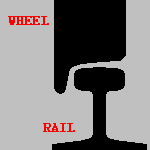
First let's discuss what keeps the car on the tracks. The force pulling the car into the curve is the Centripital Force, the generic name for the net force which pulls and object in an arc. The components of the Centripital foce are 1) the preceeding and following cars through the couplers 2) the frictional force between the wheel treads and the railhead 3) Gravitational force IF the track is superelevated (banked). This force tends to coutneract Inertia, but since it is applied to the lower quarter of the car, the result is a torqe on the car around the center of gravity (COG), tending to rotate it towards rolling out of the curve. More important to use here, it also effects the the centering action by pushing the trucks toward the inside of the curve relative to the car's center of gravity .
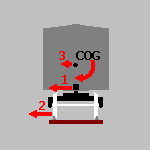
Now Intertia and the Centripital Force counteract to prevent the car from flying off the inside or outside of the track, but what keeps the flanges from hitting the rail? Now consider the trucks as a separate system from the rest of the car. A state of equilibrium exists at a point where the circumfrance of each wheel, where it contacts the rail, matches the distance it needs to travel in one revolution.
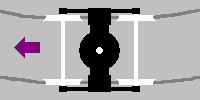
Prior to reaching equilibrium the outer wheel is climbing the outer rail, and we will call this state Undercompensation. Until it reaches that point, there is a drag force (against the direction of travel) on the outer wheel as where it is being forced by the inner wheel to rotate too slowly to cover the distance it must travel. Similarly the outer wheel is forcing the inner wheel to rotate too fast causing a tractional force (in the direction of travel). These forces excert a torque on the truck around a vertical axis at its connection to the car. This torque pushes the the lead outer wheel higher on the rail (giving it a larger diamater) and the lead inner wheel lower (giving it a smaller diameter). The trailing wheels tend to follow the path of the lead wheels forcing the system toward the equilibrium point.
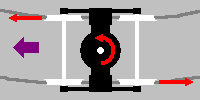
Now these forces, and hence the torque, are zero at the equilibrium point, but the forces prior to equilibrium may be great enough to cause and overshoot, and we will call this state Overcompensation. When this happens or when the car is leaving the curve, the diamater of the inner wheel is now too small and is dragging and that of the outer is too large causing a tractive force. The forces are now reversed and exert a torque in the reverse direction that causes the lead outer wheel lower on the rail (giving it a smaller diameter) and the lead inner wheel up on the rail (giving it a larger diameter). This again forces the system back toward the equilibrium point.
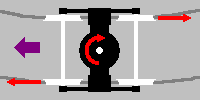
The slightest Overcompensation would cause a oscillation between these two states if there was not lateral friciton beween the rail and the wheel. So in this way the trucks find their way to the equilibrium point. The exact location of the equilibrium point depends on the forces acting on the system, especially gravity, the Centripical force, and the geometry of the track.
This centering action does not always work well enough. If you observe a heavily loaded or fast moving train on a curve, you will hear a periodic sqeek or lonq squeal. This results from the Overcompensation to the extent that the wheel flange bumps the rail head (squeek) or slides along it for a time (squeal), until the centering action takes it back towards equilibrium. This can also be exagerated by bad track (crowned sectional rail for example) which forces the wheels back and forth.
The squeal results from the fact the flange strikes the rail just before the bottom of travel while it is still moving downward. Also, as the wheel climbs into the steepest segment of the hyperbole, gravity takes over to foce the wleel back down the flange. So we have friction versus gravity resulting in metal scraping on metal. This is undesired, but normal, and flange greasers are often installed preceeding tight curves on mainlines to cut down on damage resulting from this.
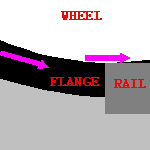
A worse scenario is wheel creep. Once the flange hits the rail the centering action only serves to force the flange into the rail. If the wheels cannot reach the correct diameter to match their distance of travel and periodically either the inner wheel slips backward or the outer wheel slips forward. The former is more likely since the inner wheel has less contact area with the rail and hence less friction. This causes the POP-POP sound created on very tight curves.
A differnt solution than traditional centering action is self steering trucks as applied on some new locomotives. in this system the axles independently rotate slightly in the truck frame to individually remain tangent to the rail. In this way the centering action does not occur as suddenly, reducing the Overcompensation that causes flange and rail wear.
The seemingly obvious solution is to split the axle in the middle, and put bearings there. The problem with this is that without the centering action that forces the truck around the curve, the truck would always plow straight ahead until the flanges hit the rail.
In extreme cases the inside head of the rail can sink as much as an inch in relation to the outside, and eventually the inside part of the rail, or even the entire head, will crack and break off. Extremely worn rail will apper as it was melted by extreme heat on its inner side.
The other major defect in wheels is a result of stoppling. In emergency situations, and engineer can release all the air from the trains braking system, causing the air reserviors on each car to apply the brakes fully. This can cause the weels to lock up and skid, grinding part of the weel flat. A flat wheel will cause a CLANK-CLANK sound as it passes. It causes extreme stress in both the rail and the car as it punds the track. In extreme cases, the inbalance and forces can acually cause the weel to jump off the rail each revolution, exagerating the problem. The forces applied by flat wheels is a major cause of broken rails. Skidding can also be caused by and overheated bearing which seizes.